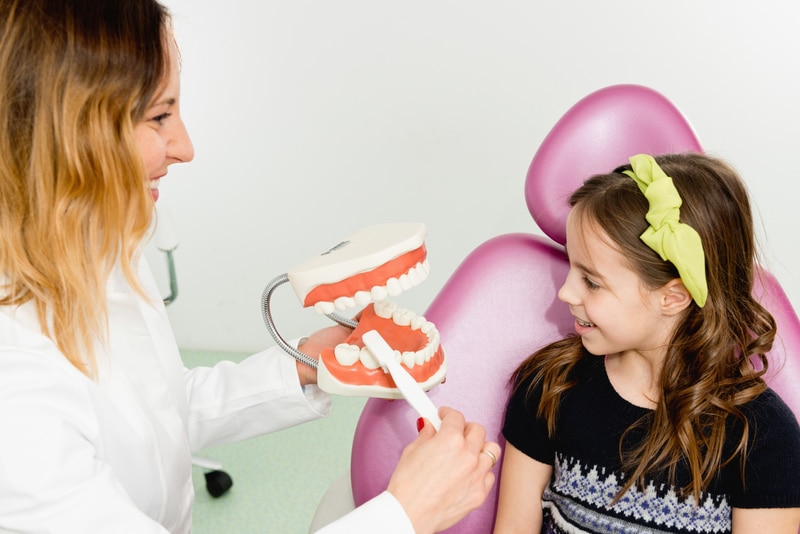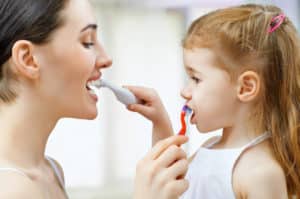Teaching Children to Brush and Floss Their Teeth


If you are a first-time parent, knowing how to teach your child about brushing and flossing can be difficult. It can even be difficult to teach your children how to brush and floss even if you are an experienced parent. Everyone—not just children–needs a proper oral hygiene routine to avoid major oral health problems such as tooth decay and gum disease. Brushing and flossing can help you avoid even more problems than that. The key is to teach children how to brush and floss when they are young and how to do it correctly. Find out what the oral hygiene guidelines are for toddlers, children, adults, and how to teach them to your children!
Teaching Children to Brush Their Teeth
Brushing and flossing are the basics of having great oral health. You can’t only do one and expect to avoid tooth decay and gum problems. You need both, plus visits to the dentist, good nutrition and more. To brush properly, a child needs to brush for about 2 minutes, at least twice a day. You will have to monitor that brushing to make sure it’s not done in 20 seconds instead of 2 minutes. Many parents set a timer or play a song for their children and they have to brush the entire duration of the song. Have them brush their top teeth the first minute and the bottom teeth the second minute.
It’s important to teach children that they have to brush all of their teeth every single time they brush. They should brush back and forth, but also change the angle that they brush, so they get the gum line and get food out that is stuck. It helps to also brush in a circle on the back teeth that are bigger. Many people forget to brush their tongue, which is a haven for bacteria. Make sure your child brushes their tongue after brushing their teeth and that they rinse off their toothbrush after every brushing. Kids need about a pea-size amount of toothpaste, but can increase the amount they use as they age. Letting your child pick out their toothbrush can help them to have the desire to brush their teeth. Making charts that help them or reward them if they brush and floss is also helpful.

Teaching Children to Floss Properly
Flossing is an integral part of having good oral health. Children must brush and floss to avoid cavities. If they only do one, odds are that they will get cavities, which means their teeth will decay. That also means a dentist will have to take out the decay and fix their tooth, which they don’t want. Explain that preventing cavities is much easier than getting a cavity and having to have a dentist fix it. Flossing is easy for adults, but can be difficult for small children. You will have to start flossing your child’s teeth for them as soon as the teeth are too close together for the bristles of a toothbrush to get in between them.
Teach children how to wrap the floss around either their pointer or middle fingers. Make sure that they don’t wind the floss too tight around their fingers. Show them how to floss in between all the teeth. We have found that many children do well with the small handheld tooth flossers until they have the dexterity to use floss like adults do. You can get bright, colorful flossers that can help children have the desire to floss.

Take the Time to Teach
Teaching children how to take care of their oral health takes time. However, it only takes time when they are small. If you take those few minutes every day to teach children how to brush and floss correctly, they will be able to eventually do it by themselves forever after. Not enough children are taught the basics of brushing and flossing and why both of these habits are so important to their health. That is probably the reason that so many adults have tooth decay and gum disease. When taught young and taught correctly, a child is more likely to have better oral hygiene habits and stick to those habits as they grow into an adult.
If you have a busy schedule, then monitor your child’s brushing and flossing while you are doing the same thing. You can both benefit from brushing and flossing together morning and night. Children are more likely to do something if they see their parent or guardian doing the same thing as well. Your example is the best asset you can give when teaching children to brush and floss. Remember that you will have to brush and floss your child’s teeth for the first few years and help them when they are toddlers until they learn how to properly brush and floss themselves. If you are struggling with teaching a child how to brush and floss, we can help! Call Dr. Ania’s office today at 303-443-0998 for all you and your child’s oral hygiene needs.


